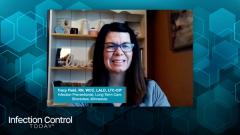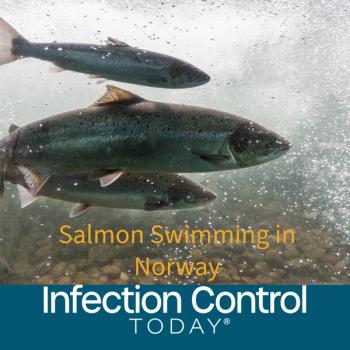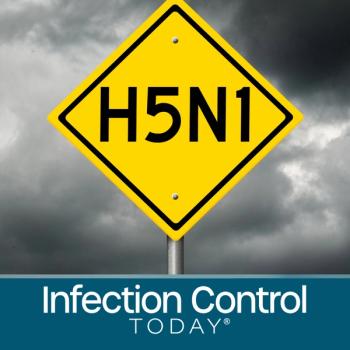
PPE Protection Considerations
Experts in infection prevention discuss how PPE protects both the wearer and others, and how a well-fitting mask ensures high protection from germs and other infectious substances.
Episodes in this series

Heather Saunders, MPH, RN, CIC: I told you we were going to get back to masks and I want to pause and talk a little bit about the difference between source control and a personal protection mask. What is the difference when we use those terms, source control or personal protection?
Isis Lamphier, MPH, CIC: Source control is to protect a person’s mouth and nose and reduce the spread of those respiratory droplets. Personal protective equipment will protect the wearer. Source control will help reduce those droplets that are naturally transmitted when a person talks, sneezes, or coughs.
Heather Saunders, MPH, RN, CIC: I know that with surgical masks, some of them we have ties, some of them we have ear loops. Does it matter? Does it impact the protection of the wearer or the individual that is being protected from the wearer?
Tracy Field, RN, WCC, LALD, LTC-CIP: The main thing is that it’s a well-fitting mask on your face and that you don’t have any gaps. So whether you use the straps or the ear loops or the ties, it’s just a matter of making sure that your face is completely protected.
Isis Lamphier, MPH, CIC: Also, that it’s secured. Especially if you’re going into a room that requires isolation, you want to ensure that that mask will definitely stay on the whole duration that you’re in there. Choose a mask that’s properly secure and you know will stay on.
Heather Saunders, MPH, RN, CIC: So, going back to the different types of masks, we also have tie masks versus ear loop masks, and we get a lot of questions about what is better. Having a mask that ties in the back behind the head or having a mask that has the elastics that go over the ear loops. And so, there's a couple of different considerations that healthcare workers and institutions can have and take here. And again, we want to always go back to what is the level of protection that we need to be providing our healthcare workers, providing ourselves when choosing what type of mask we're going to wear. Do we need a respirator, or do we need just a general surgical mask? But once we take care of that, we can look at what type of mask, ear loop, or tie we would prefer. Because it really goes back to preference. There's a couple of different considerations that you might want to pay in mind when you're making this decision. One of which is thinking about the length of time that you're going to be wearing this mask. Sometimes the ear loops over time can irritate the ears. Some people will then prefer the ties behind the back of the head, so they don't have that ear loop irritating the ears all day. For example, when wearing source control. However, that can also be avoided. There are different materials, 3D printed materials that can be worn as a headband around the back of the head, that the ear loops can secure on. Another consideration for tie masks would be that sometimes tie masks can really give us a better fit because the wearer can adjust the mask to the shape of their face and tighten the mask based on the shape of their face. Sometimes having those tie masks is advantageous for being able to tighten that mask around the face and get a really good seal. It's also important to think about the design of those masks and ensuring that the wearer's understanding of how those masks should be worn. One example of this is a lot of times masks will be flipped around where the blue side of the mask is facing inward, and the white side of the mask is facing outward. There is a correct way in which these masks should be worn. The blue should be facing outward and the white facing inward, because that blue is really the water-resistant side and the white is the absorbent side. So that's something to pay in mind too when choosing those masks, is whether or not the healthcare worker is going to be able to intuitively know which side of the mask should be facing outward, which side of the mask should be facing inward. As well as getting education on that matter.
Let's pause for just a moment and talk about what does best fit actually mean. Because I want to make sure that we understand what we mean by best fit. So, when we say best fit, best fit is really just referring to ensuring that the mask is conforming to the shape of the face of the wearer. Sometimes we have masks that will have a little bit of a gap on the outside of the face or maybe on the bottom of the face. And so best fit would just be ensuring that there are no gaps around the seal of the mask. And that's really what we refer to as best fit. But there are all kinds of different shapes of masks. And there's different materials of masks. Let's just, for example, talk about the duck shaped masks. We've heard about these duck shaped masks. They look kind of like a duck bill. What's the purpose of the duck shaped mask, is there any benefit to it, advantage over other types of masks? So, I would say with the duck shaped masks, the goal here and the purpose, the reason behind having these is really to have more breathing room. It's the breathability aspect of the mask that we're trying to achieve with the duck shaped mask. But that really is not lending itself to the level of protection that those masks are offering to us. We want to make sure and go back and look at the mask, whatever duck shaped mask we have and see is that a respirator mask that requires us to do some fit testing. Or is it just a regular surgical mask that is duck shaped or duck bill shaped? That would be something that we would want to look at. But that shape may offer wearers some more breathability, which really lends itself to comfort.
Another consideration that facilities might have is that tie masks are going to take a little bit longer to put on, because of course we have to tie the mask behind the back of our head. It also is going to take a little bit longer to take off since we'll have to untie those masks and it could be a little bit more challenging for the healthcare worker to reach behind their head and untie those without any contamination. So, the facility is going to want to take that into consideration. Also take into consideration if these masks are going to need to be put on quickly, then tie masks may not be the most advantageous option for that facility.
So, we need to look back at the level of protection that that mask is offering, because the shape of the mask does not always equivalate to the level of protection. We want to understand is that mask a respirator mask or is it a surgical mask? Because a surgical mask is going to offer protection against diseases that are transmitted by droplets. And those N95 or respirator masks are going to offer protection against those diseases that are transmitted by aerosol. So, we want to understand the level of protection the mask is providing and then we can look at what mask is more comfortable for a healthcare worker. It’s really difficult with all the different types of masks to know which masks people should be wearing. So just knowing that a well-fitting mask is what we really want to see.
Transcript edited for clarity
Newsletter
Stay prepared and protected with Infection Control Today's newsletter, delivering essential updates, best practices, and expert insights for infection preventionists.










